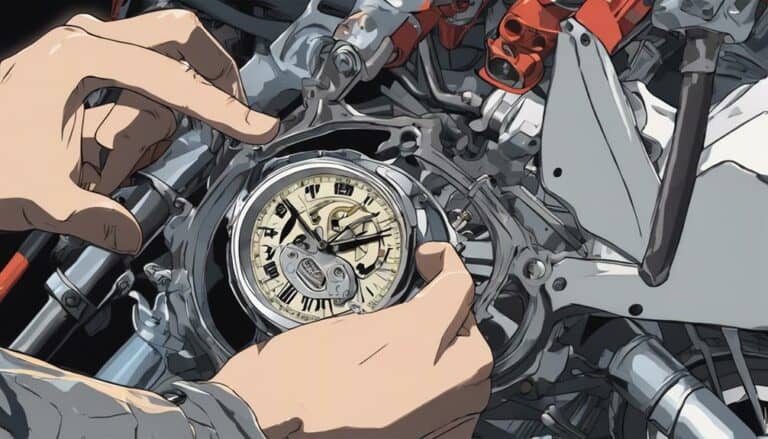Setting the time on a dirt bike may seem like a simple task, but ensuring precise timing can make a world of difference in your bike's performance. From aligning the piston to adjusting the tensioner, each step plays a vital role in maximizing engine efficiency.
However, there's one essential aspect that many overlook – the impact of time on the engine's overall health. By mastering the art of setting time on your dirt bike, you not only enhance performance but also prolong the life of your trusty companion.
Key Takeaways
- Use a timing light to align marks on the flywheel for optimal engine performance.
- Adjust time settings through the display panel's menu for accurate time representation.
- Set the correct time zone according to manufacturer specifications for proper engine operation.
- Calibrate timing accuracy using a timing light on engine marks and adjust as needed for peak performance.
Checking the Current Time Setting
To begin evaluating the current time setting on your dirt bike, remove the timing plug to expose the timing marks on the flywheel. The spark plug plays an important role in this process as it indicates the ignition timing. Use a timing light to illuminate these marks for a precise reading. Make sure the marks align with the correct degree mark specified by the manufacturer to guarantee peak engine performance.
If adjustments are necessary, rotate the stator plate or camshaft until the marks are properly aligned. Once the timing is set correctly, reinstall the timing plug and double-check the timing setting before starting the engine. Proper timing not only improves engine efficiency but also prevents issues such as poor acceleration and engine knocking.
Adjusting the Time on the Display
If you need to adjust the time on your dirt bike's display, start by locating the settings menu on the display panel. Once you've found the settings menu, use the arrow buttons or select button to navigate to the time setting option.
Select the time setting, and then use the arrow buttons to adjust the hours and minutes to the correct time. Make sure to confirm the new time setting by pressing the select or OK button.
After completing these steps, the time on the display should now accurately reflect the time set on your dirt bike. This adjustment guarantees that you stay on track and in control of your schedule while the engine is going.
Setting the Correct Time Zone
When setting the correct time zone on your dirt bike, make sure you refer to the manufacturer's specifications for accurate adjustment. It's essential to follow these instructions meticulously to guarantee your dirt bike operates at its best.
Here are some important steps to help you set the correct time zone effectively:
- Consult the Owner's Manual: Check the owner's manual for specific guidelines on setting the time zone. The manual will provide detailed instructions tailored to your dirt bike model.
- Contact the Manufacturer: If you're unsure about the correct time zone setting, don't hesitate to contact the manufacturer directly. They can offer expert advice and guidance.
- Use a Timing Light or Timing Marks: Utilize a timing light or timing marks to make precise adjustments to the time zone. This ensures accurate timing alignment.
- Ensure Engine Specific Requirements: Set the time zone according to your dirt bike's engine specifications for best performance. Matching the time zone to the engine requirements is important for efficient operation.
Calibrating the Time Accuracy
Calibrate the time accuracy of your dirt bike by utilizing a timing light to confirm precise ignition timing alignment.
To begin, locate the timing marks on your dirt bike's engine case. Connect the timing light according to the manufacturer's instructions, making sure a secure attachment to the spark plug wire. Start the engine and point the timing light at the timing marks. The strobe from the timing light will illuminate the marks, indicating the current ignition timing.
Compare this to the specified timing in your dirt bike's manual. If adjustments are necessary, follow the guidelines provided by the manufacturer to adjust the timing. Typically, this involves rotating the stator plate or adjusting the CDI unit.
Once the timing is set correctly, recheck to confirm accuracy. Properly calibrated ignition timing will enhance fuel efficiency, power delivery, and overall performance of your dirt bike, bringing back its peak function.
Regularly calibrating the timing accuracy will help maintain peak performance over time.
Troubleshooting Time Setting Issues
To resolve time setting issues on your dirt bike, meticulously examine the alignment of timing marks on both the camshaft and crankshaft gears. Ensuring these marks are correctly aligned is essential for the proper functioning of your bike's engine timing. Additionally, make sure the piston is at top dead center (TDC) before adjusting the timing to prevent any misalignment issues.
Here are some key steps to troubleshoot time setting problems effectively:
- Check for proper alignment of timing marks on the camshaft and crankshaft gears.
- Make sure the piston is at top dead center (TDC) before setting the timing.
- Verify that the timing chain is correctly installed and tensioned to avoid timing issues.
- Double-check the valve clearance adjustment as it can affect the engine's timing accuracy.
Conclusion
Now that you've successfully set the time on your dirt bike, are you ready to experience peak engine performance and longevity on your next ride?
Remember, proper timing is key to preventing engine damage and ensuring best operation. By following these steps and fine-tuning the timing chain tension, you're setting yourself up for a smooth and powerful ride every time.
So, are you ready to hit the trails with confidence and precision?

